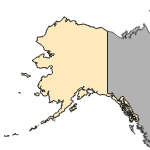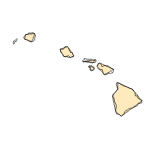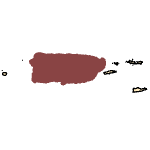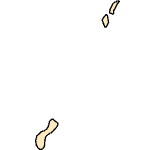Pomacea bridgesii
(spiketop applesnail)
Mollusks-Gastropods
Exotic |
|
Common name: spiketop applesnail
Synonyms and Other Names: Ampullaria bridgesii Reeve 1856
Taxonomy: available through
www.itis.gov
Identification: Large snails reaching several inches in diameter, shells are yellow to brown and may have banding.
Size: 65 mm shell height (Pain 1960)
Native Range: Tropical and subtropical South America



|

Alaska |

Hawaii |

Puerto Rico &
Virgin Islands |

Guam Saipan |
Hydrologic Unit Codes (HUCs) Explained
Interactive maps: Point Distribution Maps
Nonindigenous Occurrences:
Table 1. States with nonindigenous occurrences, the earliest and latest observations in each state, and the tally and names of HUCs with observations†. Names and dates are hyperlinked to their relevant specimen records. The list of references for all nonindigenous occurrences of Pomacea bridgesii are found here.
Table last updated 1/4/2026
† Populations may not be currently present.
Ecology: Freshwater lakes, rivers, streams, ponds and ditches preferring slow-moving water. Applesnails are tropical to subtropical organisms and cannot survive below 50oF in the winter (Florida DOACS 2002). The sexes are separate and fertilization is internal. Pale pink eggs are laid and hatch in 2-3 weeks.
Means of Introduction: Pomacea bridgesii is very common in the aquarium trade and was most likely introduced through this pathway.
Impact of Introduction: Aditya and Raut (2001) found a wide range of food acceptability that included weeds, garden vegetation, oligochaetes, snail eggs, decomposing decapods and molluscan flesh, birds and mammals (cut pieces of meat). They further stated that animal food was preferred to plant food.
References: (click for full references)
Aditya, G. and S. K. Raut. 2001. Food of the snail,
Pomacea bridgesi, introduced in India. Current Science 80(8):919-921.
Florida Dept. of Agriculture and Consumer Services. 2002. Applesnails. Technical Bulletin Number 3, 4 p. accessed 6/28/2012 at http://edocs.dlis.state.fl.us/fldocs/doacs/aquaculture/techbull/2002no3.pdf.
Pain, T. 1960. Pomacea (Ampullariidae) of the Amazon River system. Journal of Conchology 24:421-432.
Savaya-Alkalay, A., Ovadia, O., Barki, A., and A. Sagi. 2018. Size-selective predation by all-male prawns: implications for sustainable biocontrol of snail invasions. Biological Invasions 20:137–149.
Author:
Benson, A.J.
Revision Date: 1/23/2020
Citation Information:
Benson, A.J., 2026, Pomacea bridgesii (Reeve, 1856): U.S. Geological Survey, Nonindigenous Aquatic Species Database, Gainesville, FL, https://nas.er.usgs.gov/queries/FactSheet.aspx?speciesID=982, Revision Date: 1/23/2020, Access Date: 1/4/2026
This information is preliminary or provisional and is subject to revision. It is being provided to meet the need for timely best science. The information has not received final approval by the U.S. Geological Survey (USGS) and is provided on the condition that neither the USGS nor the U.S. Government shall be held liable for any damages resulting from the authorized or unauthorized use of the information.